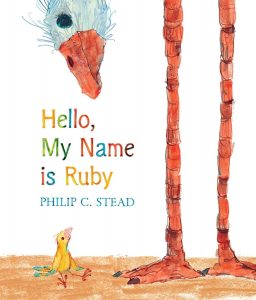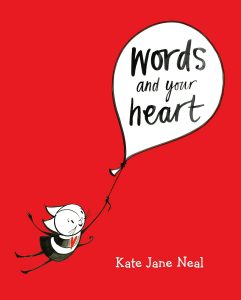Communication is one of the three Core Competencies in the BC Curriculum; Communicating is one of two components of this competency. Listed below are selected teacher resources and picture books related to communication and communicating.
La communication est l’une des trois compétences de base du programme d’études de la Colombie-Britannique ; la communication est l’une des deux composantes de cette compétence. Vous trouverez ci-dessous une sélection de ressources pour les enseignants et de livres d’images liés à la communication et au fait de communiquer.
Ressources pour les enseignant (Teacher Resources)
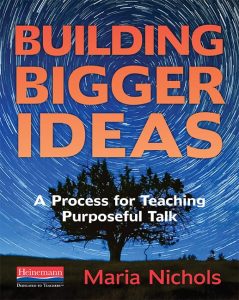 Building bigger ideas: a process for teaching purposeful talk,
Building bigger ideas: a process for teaching purposeful talk,
by Maria Nichols
Niveau scolaire (Grade level): K – 6
Maria Nichols guides us beyond teaching students to talk politely about books to teaching them to have meaningful conversations-purposeful talk that serves as a tool for constructing understanding with others. She provides a flexible process that gives teachers a solid foundation in facilitating discussions, allowing them to meet the challenges of unpredictable, exploratory talk in the elementary classroom.
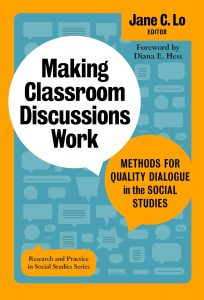 Making Classroom Discussions Work: Methods for Quality Dialogue in the Social Studies,
Making Classroom Discussions Work: Methods for Quality Dialogue in the Social Studies,
by Jane Lo
Niveau scolaire (Grade level): K – 12
For the past 2 decades, the field of social studies education has seen an increase in research on the use of discussions as an essential instructional technique. This book examines the importance of using quality dialogue as a tool to help students understand complex issues in social studies.
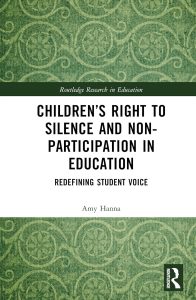 Children’s Right to Silence and Non-Participation in Education: Redefining Student Voice,
Children’s Right to Silence and Non-Participation in Education: Redefining Student Voice,
by Amy Hanna
Niveau scolaire (Grade level): K – 12
This insightful book re-examines the concept of student voice through an exploration of children’s implicit right to silence and non-participation. Responding to calls for more critical approaches to children’s participation under the UN Convention on the Rights of the Child, this unique exposition of silence ventures beyond traditional notions of voice as a defining term for justice and participation, and traditional understandings of silence as powerlessness.
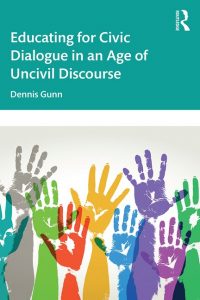 Educating for Civic Dialogue in an Age of Uncivil Discourse,
Educating for Civic Dialogue in an Age of Uncivil Discourse,
by Dennis Gunn
Niveau scolaire (Grade level): K – 12
As an invitation to ongoing civil dialogue with diverse voices in the classroom, the book aims to foster the skills of democratic and global citizenship that allow students to find their voice as local, national, and global citizens outside of the classroom. It suggests practical ways that teachers can promote the skills of attentive listening, intelligent questioning, reasonable positioning, and responsible dialogue in order to encourage authentic civic discourse.
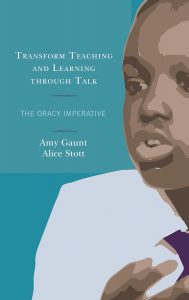 Transform teaching and learning through talk: the oracy imperative,
Transform teaching and learning through talk: the oracy imperative,
by Amy Gaunt & Alice Stott
Niveau scolaire (Grade level): K – 12
Transform Teaching and Learning Through Talk describes how to: Identify and teach good talk (and listening!)Build a classroom culture which values talk. Create meaningful and authentic contexts for oracy. Support your quietest students to speak up too! This book is a rich resource for teachers, drawing upon key academic research and outlining what this could look like in your classroom.
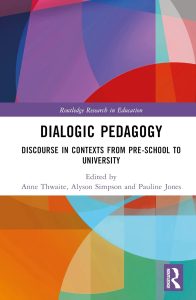 Dialogic Pedagogy: Discourse in Contexts from Pre-school to University,
Dialogic Pedagogy: Discourse in Contexts from Pre-school to University,
by Anne Thwaite, Alyson Simpson & Pauline Jones
Niveau scolaire (Grade level): Préscolaire – 12 (Pre-K – 12)
Taking a dialogic approach, this edited book engages in analysis and description of dialogic discourse in a number of different educational contexts, from early childhood to tertiary, with an international team of contributors from Australia, Finland, New Zealand and the United Kingdom. The chapters focus mostly on dialogic face-to-face discourse, with some examples of online interactions, and feature insights from educational linguistics, particularly the work of Michael Halliday.
 Unpacking Students’ Engagement with Feedback: Pedagogy and Partnership in Practice,
Unpacking Students’ Engagement with Feedback: Pedagogy and Partnership in Practice,
by Anastasiya Lipnevich, Jessica To & Kelvin Tan Heng Kiat
Niveau scolaire (Grade level): K – 12
Learners of all levels receive a plethora of feedback messages on a daily – or even hourly – basis. Teachers, coaches, parents, peers – all have suggestions and advice on how to improve or sustain a certain level of performance. This volume offers insights into the complexity of students’ engagement with feedback, the diversity of teachers’ feedback practices, and the influence of personal assessment beliefs in tension with prevailing contexts.
Les livres d’images (Picture Books)
by Soyung Pak; illustrated by Susan Kathleen Hartung
Niveau scolaire (Grade level): Préscolaire – 2 (Pre-K – 2)
Although Juno, a Korean American boy, cannot read the letter he receives from his grandmother in Seoul, he understands what it means from the photograph and dried flower that are enclosed and decides to send a similar letter back to her.
by Carson Ellis
Niveau scolaire (Grade level): Préscolaire – 12 (Pre-K – 12)
Readers are invited to imagine the dramatic possibilities to be found in the natural world, even the humblest back garden! With exquisitely-detailed illustration that will appeal to children and art-lovers alike, and a wonderfully playful invented language, we soon find ourselves speaking “Bug” … Du iz tak? What is that?
by Philip C. Stead
Niveau scolaire (Grade level): Préscolaire – 2 (Pre-K – 2)
Join Ruby, a plucky little bird, as she ventures through life, making new friends, learning new skills and asking questions which may have some very surprising results.
by Allen Say
Niveau scolaire (Grade level): Préscolaire – 6 (Pre-K – 6)
The Kamishibai man used to ride his bicycle into town where he would tell stories to the children and sell them candy, but gradually, fewer and fewer children came running at the sound of his clappers. They were all watching their new televisions instead. Years later, the Kamishibai man and his wife made another batch of candy, and he pedaled into town to tell one more story—his own.
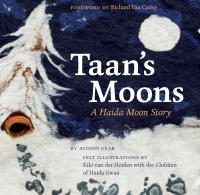 Taan’s moons: a Haida moon story,
Taan’s moons: a Haida moon story,
by Alison Gear; illustrated by Kiki van der Heiden with the Children of Haida Gwaii; foreword by Richard Van Camp
Niveau scolaire (Grade level): 2 – 5
“There’s a moon in the sky. It looks like a drum, which guides the earth where Taan is from.” In the Haida language, ‘taan’ means bear; the Haida people record time according to the way the bear follows the seasons of the year. This is a story of the bear and the seasons – or moons – of the year.
by Kate Jane Neal
Niveau scolaire (Grade level): Préscolaire – 2 (Pre-K – 2)
This book is about your heart (the little bit inside of you that makes you, you!) The words we listen to can affect how we feel. Some words can do amazing things and make us happy. And some words can really hurt us (we all know what sort of words those are). Our words have power, and we can choose to use them to make the world a better place.
Trouver d’autres ressources
Voici quelques conseils pour trouver d’autres ressources dans ce domaine :
- Sur la page principale du site de la bibliothèque de l’UBC, utilisez la boîte de recherche générale pour rechercher des matériaux à travers toutes les succursales de la bibliothèque de l’UBC.
- Pour limiter vos résultats aux matériels disponibles à la Bibliothèque de l’éducation, visitez le site web de la Bibliothèque de l’éducation et effectuez une recherche à l’aide de la case “Search Education Resources” située dans la bande à gauche de l’écran.
- Remarque : les ressources étant principalement cataloguées en anglais, les termes ci-dessous donnent généralement plus de résultats que les recherches effectuées en français. Vous pouvez filtrer votre liste de résultats par langue dans la barre latérale de gauche.
- Utilisez des termes de recherche spécifiques, tels que
- “communication in education”, “communication” OR “conduct of life” OR “caring” AND “child*”, “friendship” AND “juvenile fiction” OR “picturebooks”, ou “dialogic approach” OR “dialogic discourse” OR “dialogic perspectives” AND “education”
- Pour trouver des plans de cours, incluez “lesson plans”, “lesson planning”, or “activity programs” dans vos termes de recherche.
Finding More Resources
To find more resources in this area, try the following:
- Search using the General tab on the UBC Library website to look for material in all UBC Library branches.
- Search using “Search Education Resources” box in the left hand bar on the Education Library website to limit your results to physical materials in the Education Library.
- Use specific search terms, such as
- “communication in education”, “communication” OR “conduct of life” OR “caring” AND “child*”, “friendship” AND “juvenile fiction” OR “picturebooks”, and “dialogic approach” OR “dialogic discourse” OR “dialogic perspectives” AND “education”
- To find lesson plans, include “lesson plans”, “lesson planning”, or “activity programs” in your search terms.


